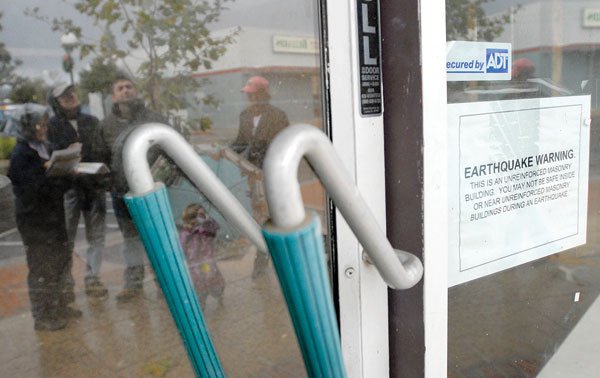
It’s been less than a month since City Council directed staff to further investigate financing options for downtown’s 18 unreinforced masonry buildings (deemed structurally unfit to survive a major earthquake) and to report back in the fall.
The two options that staff will be taking a closer look at – a Voluntary Seismic Safety Assessment District and a Community Facilities District – would be funded by a City bond issue paid for by way of an assessment on the URM owner’s property tax bill. Both are seen as a way to help URM owners find the funding to complete the City required retrofits, allowing the buildings to be occupied again.
Prior to that on May 20, Council directed staff to reconvene the URM Task Force to take another look at the present URM ordinance. That meeting is scheduled for next Tuesday.
So, it came as a surprise to local developer Gary Walton, a member of Gilroy’s URM Task Force, to see a roll-call vote placed on Monday night’s regular Council meeting agenda for a motion to adopt a resolution allowing the City to impose real property liens for delinquent administrative citations.
In plain English, it would mean that URM owners cited for not completing structural retrofits will have to start paying the City fines that have been accumulating against their properties.
“Intimidation doesn’t work so well,” Walton explained. “They’ve already got these people riled up as it is.”
Next Monday, Council will decide whether to go ahead with administrative efforts to recover unpaid fines that have stacked up against eight of the 18 URMs – just one day before a meeting of the City’s URM Task Force, which hasn’t met since the present URM ordinance was drafted in 2011.
Community Development Director Kristi Abrams is responsible for the report that details the amounts owed by certain property owners in the city, along with Code Enforcement Officer Scott Barron. Abrams says the list of delinquent citations coming before Council is just a matter of administrative routine.
“It’s normal to go through a lien process at this time of year,” Abrams explained. “All outstanding code enforcement fines are on this list.”
Mayor Pro Tempore Perry Woodward acknowledges some people might have concerns over a meeting exploring options to help URM owners taking place a day later than a vote to impose punitive punishments.
“I can see the paradox of the timing,” said Woodward. “But, staff has the power to put on the agenda what it wants.”
Staff may have the power to set the wheels in motion, but Council has powers of its own.
“The Council can have ultimate discretion,” Woodward explained.
That discretion could see the URM fines taken out of the final report and hashed out on the dais further.
“We haven’t had a really robust conversation since the election about what we want to do,” Woodward noted.
The URM seismic safety fines range from $2,800 to $11,400, and were calculated using the penalty structure of the present URM ordinance.
Understanding the URM saga
The issue of Gilroy’s downtown URMs has dragged on since 1986 when a state law was enacted requiring cities in “seismic zone 4” – which runs the length of the California Coast – to inventory URM buildings, establish a loss reduction program and report progress to the California Seismic Safety Commission.
In 2005, the statewide Jennifer Lynn-Myrick Memorial Law – named after one of the two victims of the San Simeon earthquake that collapsed URM buildings in Paso Robles – came into effect. It requires URM buildings to place a notice in the window informing people of the building’s inability to withstand a serious temblor. In 2011, the City’s present URM ordinance was introduced. The ordinance superseded a previous iteration in 2006, which set the standards for voluntary and mandatory seismic retrofits.
“They went beyond state law and came up with something draconian,” Walton said. “This whole thing has been a bizarre nightmare.”
The seismic retrofit includes securing URM walls to the roof and floors in multi-story buildings, repairing or removing façades and bracing parapets.
At the regular Council meeting June 17, Council members Dion Bracco and Cat Tucker suggested rewriting the ordinance to make it less stringent. That idea was rebuffed by City Attorney Linda Callon, who cautioned that allowing downtown URMs to resume business as usual could lead to the City being sued in the event of an injury.
Walton says that logic is incorrect.
“Based on Paso Robles, only the property owner was liable,” he explained. “Even if the City did nothing, they did what was required by the state.”
State law only “recommends” that local governments create ordinances for mandatory strengthening programs, seismic retrofit standards and reducing the number of occupants in a URM building, according to a 2003 report to State Legislature from the Seismic Safety Commission.
“It’s very difficult to sue the City about anything and win,” Walton laughed.
Some URM owners owe more than $130K
City Administrator Tom Haglund explained that section 6.50 of the URM ordinance authorizes the “imposition of $500 per calendar month penalties for URM property owners that fail to submit a complete building permit application and engineering analysis report by June 15, 2012 and an additional $1,000 per month for failure to complete the required mandatory retrofit requirements by June 15, 2013.”
However, two owners are in the hole for a lot more than that. Sunil Patel of Fremont has landed a total bill of $151,072 for his two properties at 7517 and 7525 Monterey St., and Lynette M. Hill, the named trustee of 7491 Railroad St., will be on the hook for $164,700 if the motion is approved, according to City documents.
The reason for Patel and Hill’s high fines is because both parties were issued citations for blight violations and abandoned constructions in addition to the URM seismic safety violations.
Taking the URM seismic safety violations out of the equation for the two owners would still leave them owing $139,672 and $153,300 respectively.
In January 2012, both owners received compliance orders to correct the violations. Both owners failed to comply with two City-issued deadlines while at the same time receiving a $100-per day penalty. There was then an administrative hearing that issued a notice of decision and order that gave both owners an additional six months to complete the necessary repairs. That order stipulated that if the owners failed again to complete the work deemed necessary, then all per-day late payment penalties and per-month late payment penalties would be enforced, according to City documents.
Finding middle ground between City and URM owners no walk in the park
“This Council is prepared to be tough,” noted Woodward.
Still, he underscores the difficult task at hand for the City in figuring out a middle ground that appeases all of the stakeholders.
“If there was an easy answer we would have found it five or ten years ago,” Woodward said.
If Council decides to forge ahead with recovering the money, the City Clerk’s Office will record the final report 30 days after the resolution as a judgment lien in the Office of the Santa Clara County Recorder, according to documents provided by the City. The unpaid fines can then be collected by escrow when the property is sold or the owner can choose to stump up the cash and get the lien removed.
“One property owner says he’s going to tear down his building because he can’t work with the City,” said Walton.
That sort of thinking creeping into the downtown mindset worries Walton. Forcing the destruction of Gilroy’s downtown heritage is something future generations won’t thank today’s decision makers for, according to the local developer.
“No one ever says, ‘Man I’m glad we tore down all our historical buildings,’” he added.
Walton doesn’t own any downtown URMs, but he is adamant City staff should rethink their approach with the seven liens included in Monday’s delinquent citations report.
“I’m trying to educate staff about the way to go,” he said. “They’ve made this huge mistake in demonizing the owners.”












